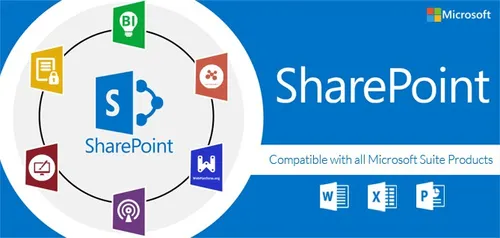
Knowledge base
April 30, 2021
SharePoint for Business: Why Use It?
Microsoft has quite a few opponents, but every now and then it produces a product that reaches the right place for many users across the board.
SharePoint is such an offer and has had good acceptance in the market in general – yes, even from some opponents.
You may not want to take the man’s vaccines, but Bill Gates has created a real business tool in SharePoint.
SharePoint excels as a web-based collaboration and content management platform.
It is a skilled competitor to Zoho and Slack, as it can very easily be used for a simple collaboration, but it can also be used as a platform for something much more ambitious, such as a global business intranet. When you include the Flow component, it becomes a process management tool. And with PowerApps, SharePoint becomes a document management solution and a mobile platform.
SharePoint is an internal data tool and – to be fair to Microsoft – it’s also a pretty neat collection of jingles and bells.
The inclusion is largely due to its usefulness, regardless of the current or historical use a company has had with Microsoft products. That tells you that SharePoint ticks almost all the boxes for most companies. When you purchase SharePoint for your business, it loads on a local server on location or, with SharePoint Online, it’s a cloud-based platform managed by a reliable IT team like Computers In The City.
Despite today’s diversity of choices, history can indeed play a role in terms of the Windows notoriety that users find, which certainly promotes acceptance, but there’s no denying that Microsoft has read the market well and created a product that’s really beneficial to business.
SharePoint’s benefits for business
That’s why – why use SharePoint?
Facilitates meaningful collaboration and project management.
Because it is a tidy offer that really facilitates collaboration and project management. The CMS touch is seductive, pushing the boundaries between website and file storage system, and SharePoint encourages gig-style collaboration.
It’s as fluid and familiar as Slack or any of the other prominent collaboration platforms, and as simple as the needs are. Global collaboration may no longer be a problem, but really good collaboration tools are still in development – there’s still a lot of room for improvement, and SharePoint is a step down that path.
SharePoint enables employees to connect and collaborate effectively in one place, a place that enables a large number of inputs and formats and also stores all collaboration data. More than that, it can facilitate easy extrapolation of that data in charts and graphs for display, while also allowing vendors and other input to be included in the development of the data that these charts and graphs compile.
Simply put, the platform enables meaningful collaboration and ensures a more accurate collection of data in the process. It then presents this collected data in simple but effective visual ways, further improving the understanding of collaboration and, ultimately, success.
Provides a single source for all data and extrapolation.
As a hub with highly detailed capabilities, SharePoint makes it possible to extrapolate each company’s data into meaningful presentations to different departments, while then discussing them on forums or through discussion forums. Instead of having to switch between email and notifications on mobile devices or half calls, a single source for all data, extrapolation and communication is much easier and certainly saves you time.
Close integration with Office 365, consistent performance, seamless and fast UX.
Closely integrated with Office 365, SharePoint Online is a gateway to the office, whether you’re working from home or elsewhere. While other platforms do too, it offers consistent performance across devices – something it challenges for many competitors – and the user experience is seamless and fast.
Provides enterprise-level security.
SharePoint has enterprise-level security; by including such, Microsoft has taken the trouble to address current fears about the increase in cybercrime – and it is also fully scalable.
When it comes to corporate compliance obligations, Microsoft has once again ensured that its broad construction and subtle features facilitate compliance, another emerging tide of awareness.
SharePoint as a business intelligence tool
It may seem corny to say that SharePoint lets staff as individuals – and as a whole – make more informed decisions, but part of the value Microsoft presents with SharePoint is just that: Business Intelligence is rising.
Helps users make informed decisions with Business Intelligence.
Whether by design or luck, SharePoint is a more or less beneficial solution for customers looking forward to a highly unknown future, as the business community doubles its focus on business intelligence-based strategy. More than ever, the data should not slow things down, but rather allow for an acceleration in the right direction – something that is often harder to predict today than ever before.
Facilitates greater diversity of users through UX.
Getting everyone to make better decisions based on available data is an up-to-date ideal for businesses and industries facing major disruptions.
In difficult times, tools like SharePoint need to collect and present data in a fast and effective way. Perhaps insignificant – but probably also responsible for – the inclusion the platform has seen is the fact that SharePoint allows for a high degree of personalization. This may seem like a moot point, except that it allows for a wide variety of users while still getting the same data.
In any case, SharePoint is an attempt to balance UX and personal ownership of the platform, with the business dictates of clear data and unambiguous results.
We see it so often that we may find it inconspicuous, but therein lies the popularity and ultimate effectiveness of a platform.
Provides comprehensive UX and cloud-encrypted data.
The platform has integrated validation in-game, which means inconsistent or inaccurate data is flagged, eliminating the risk of human error in data capture, another great feature that drives the utility.
Access is monitored and the data is encrypted in the cloud, while SharePoint can also enable extranets, customer-facing websites, and internal social networking apps, even wikis.
Unlike a Microsoft app like Excel – where many features remain unclear to many users – SharePoint is more stimulating for extended use.
Why consider SharePoint for your business?
Overall, the platform is sleek and professional, without being difficult.
Its value to the company is best reflected in employment per company, and the platform does indeed host many of the world’s prominent business entities today.
Source: cupertinotimes
Want to know more?

Related
blogs
Tech Updates: Microsoft 365, Azure, Cybersecurity & AI – Weekly in Your Mailbox.









